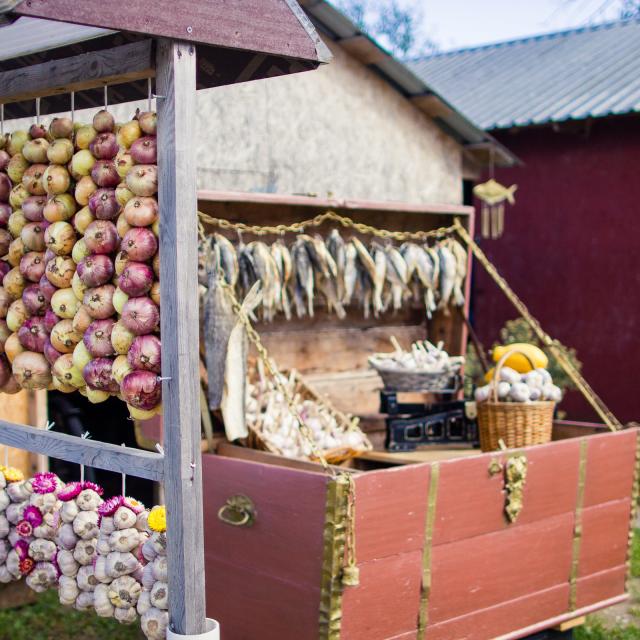Culinary regions

The Ministry of Regional Affairs and Agriculture has been selecting culinary regions since 2016. The culinary region programme is different every year, characterised by the region that holds the title. For the local community and businesses, this is an opportunity to cooperate, develop new culinary tourism services, and introduce their local area through food culture.
2016 – Year of Hiiumaa Flavours. Fish – garfish, flounder and salted Baltic herring – are definitely an inseparable part of the flavours of Hiiumaa as the second largest island in Estonia The traditional method of preparing fish, which is drying, is widely used in Hiiumaa. The Hiiu viiul (Hiiumaa violin), i.e. dried leg of lamb, is an interesting and traditional food of Hiiumaa. The tuhlitamp (mashed potatoes) has historically been another traditional food eaten in Hiiumaa. The island is also known for its coffee-drinking culture – the people of Kärdla have been called coffee guzzlers for a long time. The tradition of organising café days in Estonia also started from Hiiumaa.
2017 – Year of Peipsimaa Flavours. Peipsimaa is known as the pantry of Estonia. The culinary region of Peipsimaa consisted of four counties and its culinary culture is mainly influenced by Lake Peipus and the food heritage of the Old Believers. Peipsimaa is known for fishing and onion growing, and more recently also for growing cucumbers, tomatoes and other vegetables. The cuisine of Peipsimaa is characterised by an abundance of fish dishes and onions, all kinds of pies and a diverse use of forest fare. After the Year of Flavours, Peipsimaa has stood out as the organiser of big and innovative food events – the Great Peipus Food Festival, the Peipus Food Street, the Night Feast, and more.
2018 – Year of Pärnumaa Flavours. The flavours of Pärnumaa that characterise the region are Baltic herring and cucumber. Several recognised cider farms are also located here. Baltic herring is the everyday food of the coastal people and, as the national fish, the most highly regarded fish in Estonia, which tastes equally good whether salted, fried or marinated. Cucumbers have been a vital part of the coastal cuisine for centuries. The people of Pärnumaa have their own cucumber variety, Tahkuranna muurom, and the dedicated Cucumber Festival, which brings thousands of visitors to the area every year.
2019 – Year of Vana-Võromaa Flavours. Vana-Võromaa is a region in southern Estonia, which covers eight historical parishes of Põlva, Valga and Võru counties. The region’s cuisine is characterised by products such as smoke sauna ham, curd cheese, barley bread and fermented birch juice. The region has worked systematically for a long time to develop its food culture and has come up with the regional label UMA MEKK – OUR FLAVOUR. Vana-Võromaa has many unique small producers with a rich product range.
2020 – Year of Haapsalu and Läänemaa Flavours. Haapsalu is Estonia’s oldest resort, which in the present day is characterised by a wide range of cultural events and a café culture that started thriving in the early 19th century. Haapsalu, dotted with quaint little cafés, lives at a leisurely pace, enlivened by bustling summer events. The food culture of Läänemaa in general has been influenced by the lifestyle of the coastal Swedes. In addition to the bilingual place names on the islands of Vormsi and Osmussaar and the Noarootsi Peninsula, traces of the culinary traditions of the coastal Swedes can be found in the form of modernised traditional recipes.
2021 – Year of Northern Estonian Flavours. With the slogan “Tastes from the Limestone Coast”, Northern Estonia underlines the fact that food growing starts in the ground. Fish, potatoes and barley are typical ingredients used in North-Estonian cuisine. The food culture of the region has been influenced by the presence of beautiful manor houses, which according to food lore have played a very important role in shaping the region’s diet. For example, vodka has been an ingredient widely used in the region, as distilleries were an important part of the lifestyle of the landowners. Numerous grand glasshouses were built on manor estates in the 19th century as the importance of gardening increased. In addition to growing more exotic plants, people also enjoyed drinking coffee there in autumn and winter. The glasshouses next to the manor houses are characteristic of Northern Estonia in particular.
2022 – Year of Järvamaa Flavours. The Järvamaa culinary region is located in Central Estonia, in the heart of Estonia. Järvamaa has stood out as a dairy county – it has the most dairy cows and the largest dairy herds, is home to the most modern new dairy factories in Estonia and the Estonian Dairy Museum, which organises a milk day every year. Dairy is undoubtedly the white gold of Järvamaa, which is used to introduce the region to the wider public. When the county was the culinary region of the year, the Järvamaa Foundation registered poktail, which means piimakokteil (milkshake in Estonian), as a trademark.
2023 – Year of Mulgimaa Flavours. With the slogan “Mulgi Food – New and Old Together”, the region emphasises innovation and the potential of food technology. The main idea behind the Year of Mulgimaa Flavours is based on traditional Mulgimaa foods – Mulgi porridge (potato and barley porridge), Mulgi sauerkraut (sauerkraut with barley), Mulgi korp (flat pastry with filling) and mixed kama (mixture of grains and ground dried pulses). Mulgi porridge has been entered in the UNESCO Intangible Cultural Heritage List.